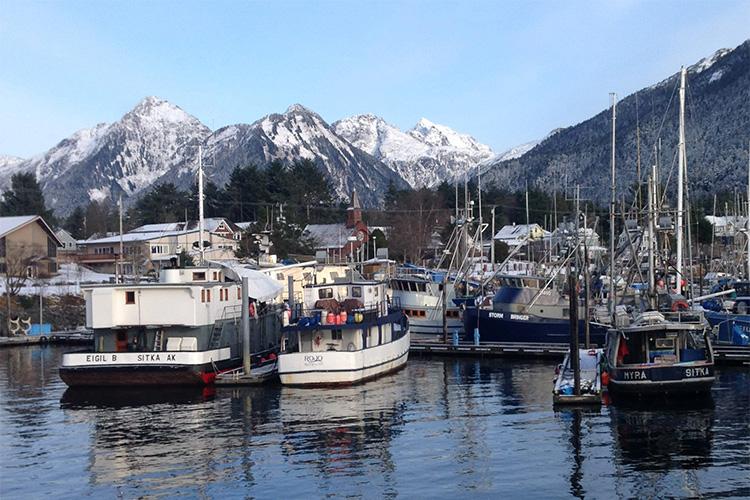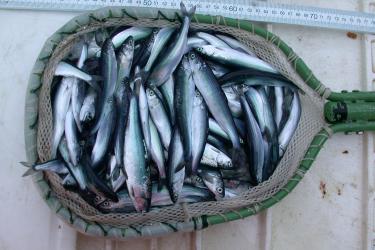Fisheries are the lifeblood of many Alaska coastal communities, serving as the cornerstone of community life, employing thousands of individuals, and providing for critical food security.
Nationally, Alaska fisheries account for more than 60% of the catch by weight in U.S. fisheries, worth over $4 billion. Six of the nation’s top ten fishing ports, ranked by value of landings, are located in Alaska. In addition, recreational fisheries provide important economic benefits for numerous coastal communities throughout the Gulf of Alaska by generating local tourism revenues.
Warming water temperatures and ocean acidification (the uptake of excess CO2 from the atmosphere that results in a decreasing pH) pose significant potential risks to various marine fisheries due to potential adverse impacts on reproduction, prey availability, and habitat. These changes pose socioeconomic risks to Alaska communities and industries. As ocean conditions continue to change, individuals, communities, and managers at all levels (from small business owners to community and tribal leaders and state and federal regulatory agencies) will need tools to comprehensively examine how management decisions will affect a range of coastal marine ecosystems, industries, communities, and initiatives.
This project is an effort for researchers to work with community members and local industry representatives to co-develop network models that capture the links between and among environmental drivers, ecosystems, and economic and social systems. Local residents will assist in characterizing network links such as social, cultural, and economic dependencies on marine resources and adaptive capacities and strategies. These models will be used to evaluate potential adaptation strategies and identify barriers to engaging in adaptation.
This work will take place primarily in four Gulf of Alaska communities with unique blends of marine resource industries and subsistence harvests: Kodiak, Homer, Hoonah, and Sitka. In addition to the community-centered approach, a regional socioeconomic impact model will be used to translate biological projections into future seafood landings, mariculture production, and availability of marine resources for subsistence and recreational users and other marine industries.
Project Update
Along with our community partners, project leaders held a series of community workshops in Kodiak, Homer, Sitka, and Hoonah. An additional workshop was held in conjunction with the Kodiak Area Native Association (KANA). Members of each community, representing locally-important industry sectors, marine users, and civic institutions, were invited to these participatory workshops. All workshops (except with KANA) were also open to all members of public and announced on local radio. Participants included commercial fishermen and processors, recreational and subsistence harvesters, aquaculture and hatchery representatives, marine tourism business owners, and municipal and tribal leaders.
The workshops were held between October 2022 and April 2024, and participation in the workshops ranged from 8 to 30 community members (in Hoonah and Kodiak, respectively). At each of the workshops, participants provided individual perspectives on their relationship to the environment, changes seen in the environment or resource availability, resource importance, vulnerabilities to continued environmental change, and adaptation strategies to observed changes. After the individual exercise, contributors joined in small group discussions (4-6 people per group), which were moderated by project team members using similar prompting questions from the individual exercise.
The recordings of the small group discussions were coded using the MAXQDA software package. Coding was done in subsets (i.e., if pink salmon was mentioned, the segment was coded “pink salmon” but placed under the larger code of “salmon”). Codes were divided into overarching categories of target species, community stressors, climate stressors, adaptation strategies, well-being dimensions, mechanisms towards adaptation, and adaptation barriers. Coded transcripts were used to develop conceptual models representing relationships communicated by contributors and supported through code interactions.
The results of those efforts are illustrated in the series of images below for each community. In each panel, issues that were raised were clustered into categories of “Stressors,” “Bio-ecological system,” “Socioeconomic system,” “Adaptation actions,” “Barriers to adaptation,” and “Mechanisms toward adaptation.” Within each category, the size of “nodes” reflects the prominence of these as discussion items in the workshops. The arrows between categories reflects the positive (green) or negative (red) effect of one category on another. For example, Adaptation actions have a positive impact on the socioeconomic system.
The results from the five individual community meetings was also compiled into a single model reflecting the broad-scale perspectives across a range of Gulf of Alaska communities.
Presentations
Webinar on Climate Vulnerability hosted by NOAA’s Ocean Acidification Program, National Sea Grant, and Climate and Fisheries Adaptation Program. (This project is the 1st of 4 presentations in that webinar). https://www.youtube.com/watch?v=I-ubv4blWrA
Poster presentation at Alaska Marine Science Symposium. January 2025. “Social, Cultural, and Economic Resilience: Assessing climate-sensitive food security vulnerability in 4 Gulf of Alaska communities.” Available at Alaska Ocean Acidification Network website: https://aoan.aoos.org/ocean-acidification-posters-from-the-alaska-marine-science-symposium/
A scientific manuscript describing the one aspect of this project is currently in development “The Community Table: Adaptations and vulnerabilities to climate change-related food insecurity in four Gulf of Alaska communities.”
This project is a collaboration between NOAA-Alaska Fisheries Science Center, Alaska Sea Grant, Wood Hole Oceanographic Institution, and the North Pacific Fisheries Management Council.
This project is funded in part by NOAA’s Ocean Acidification Program.
For additional information, or to provide input into this project, contact Dr. Thomas Hurst (thomas.hurst@noaa.gov)







